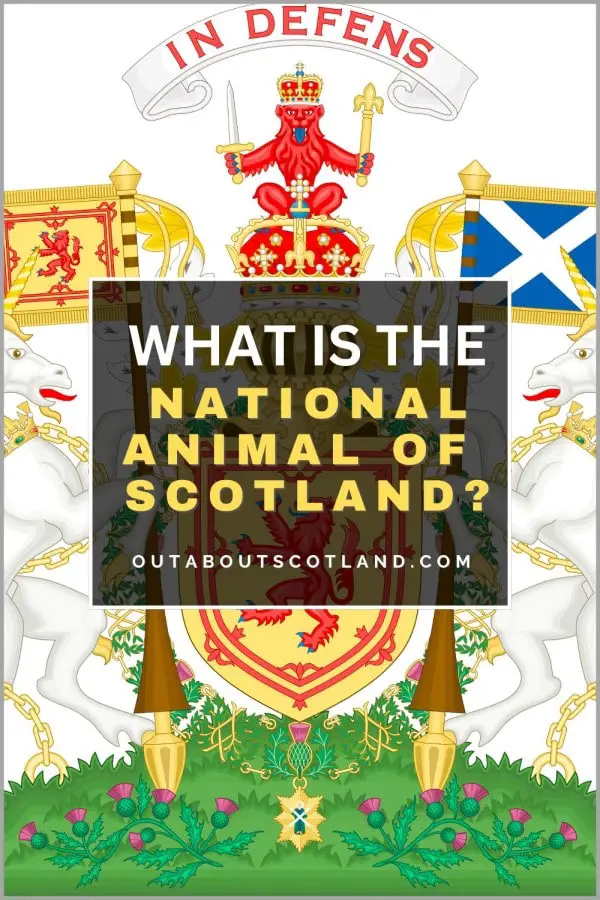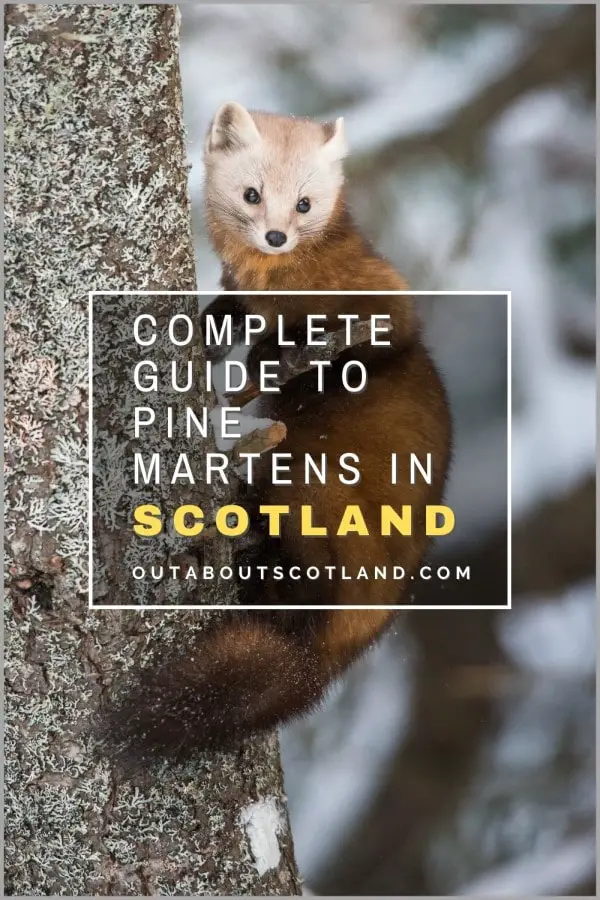It’s possible that you have never seen a pine marten unless you’ve grown up in the deepest, darkest corners of Scotland’s forests. These animals are indigenous to Scotland, and although they’re difficult to see, they are essential to the well-being of the country’s forests and woodlands.
In this article, we’ll take a close look at pine martens and cover their physical characteristics, behaviour, and preferred habitats. We’ll also delve into the challenges they face and the efforts being made to protect and conserve these fascinating animals.
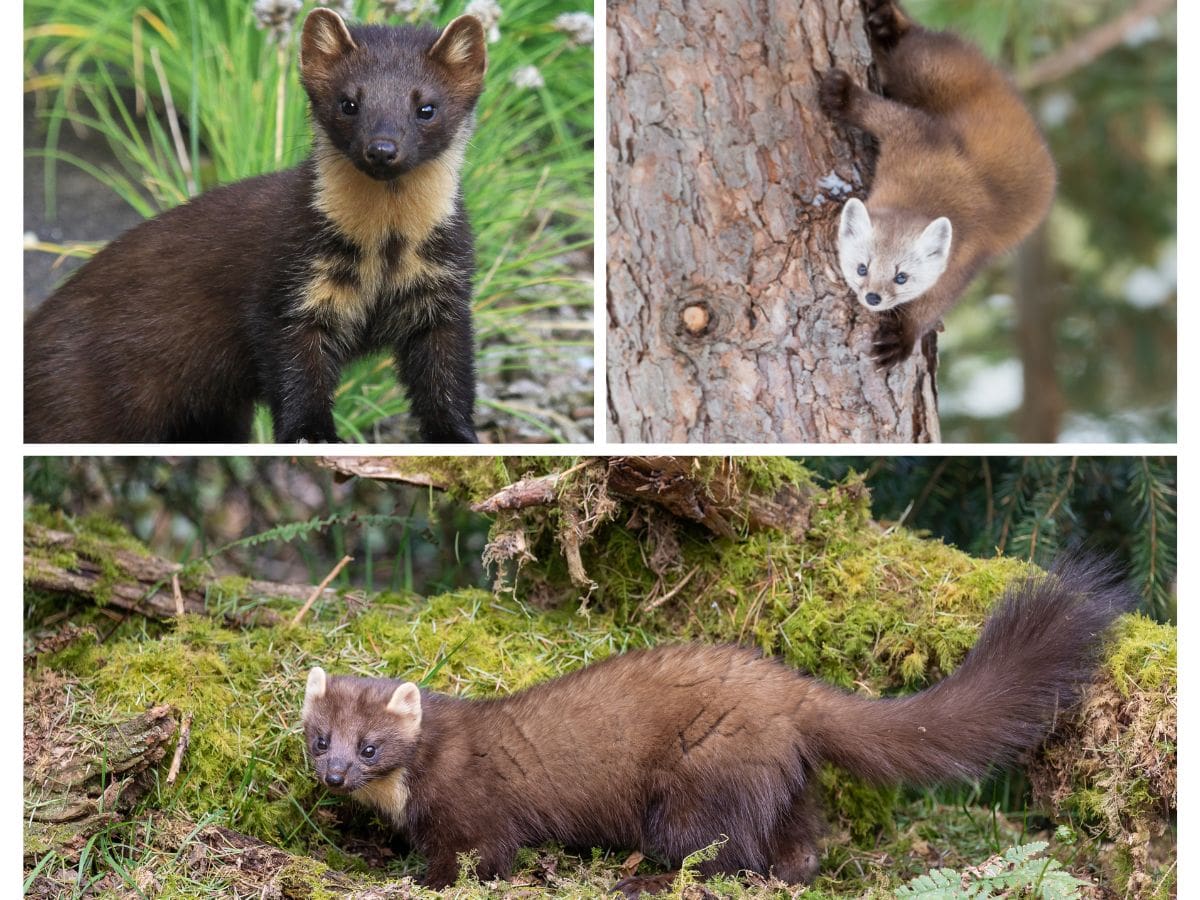
What Is a Pine Marten?
Pine martens are small, tree-dwelling animals native to Scotland that are around the same size as a domestic cat, with thick brown fur and a long, bushy tail. They are a type of mustelid, or weasel-like mammal, and have glossy coats with white patches on their throats, chests, bellies, and sometimes on their faces. They have short legs and long bodies, making them well-adapted for life in the trees, and they have sharp claws, which help them to climb and catch their prey.
Size-wise, pine martens’ bodies vary from 51 cm to 54 cm (males) and 46 cm to 54 cm (females) and have tails that are 26 cm to 27 cm (males) and 18 cm to 24 cm (females). Males weigh anywhere from 1.5 to 1.8 kg, while females generally weigh between 1 to 1.5 kg.
Except during mating season, they spend most of their time alone. They’re nocturnal animals so their daytime activity is mostly limited to sleeping high up in trees or hiding in their dens. They are omnivores (though categorised as carnivores) and consume a wide variety of foods, including rodents, birds, eggs, fruits, nuts, insects, and carrion.
They are classified as critically endangered and are a protected species under the Wildlife and Countryside Act 1981 and the Nature Conservation Act 2004.
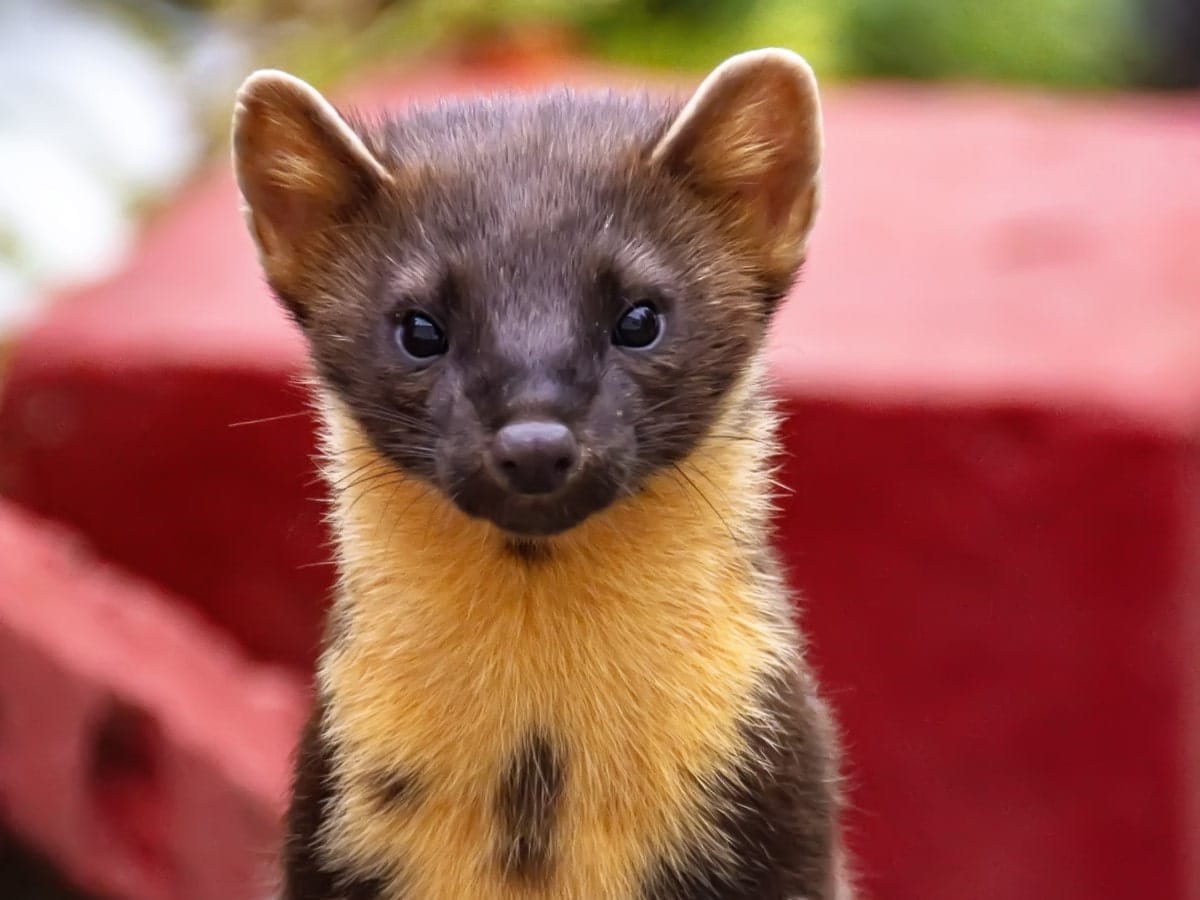
Where Do Pine Martens Live?
Pine martens are mainly found living in dense forests in Scotland although they can also be found in forest and woodland areas of Northern England and Wales. They prefer to make their homes in logs and tree cavities which serve as a safe haven where they can rest and rear their young.
They have a wide range of habitat preferences, from young conifer plantations to mature, old-growth forests, but they are most often found in areas with a mix of deciduous and coniferous trees as well as rocky hillsides. The limited number of these animals and the fact that their coats camouflage them against the bark of trees and the mud and leaves of the forest floor make them almost impossible to find.
That being said, if you’re hoping to see these elusive animals in Scotland, one of the best places to head to is the Glen Devon woodlands in Perthshire which consist of Glen Quey, Glen Sherup and Geordie’s Wood. These woodlands are very remote and have a mix of high hilltops and broadleaved trees, making them perfect pine marten habitats.
Another good location is Abriachan Wood which covers a 3-mile area on the northwest shore of Loch Ness. This is a wonderful area for wildlife spotting in general and it’s also a great place to soak up views of the loch away from crowds of tourists.
Heading further north into the Highlands takes visitors to Ledmore and Migdale National Forest which lie to the north of the Dornoch Firth. Ledmore is an ancient oak woodland, while Migdale is a pine woodland, and both are home to pine martens as well as red squirrels.

Where to See Pine Martens in Scotland
Pine martens can be seen in many different parts of Scotland but there are a few key areas where they are most commonly found. The Cairngorms National Park is one of the best areas to spot them. This vast region of unspoilt wilderness spans 1,748 square miles, so there are lots of places to head. Two of the most popular wildlife-spotting locations are Abernethy Forest and Glen Tanar.
Another good place to see pine martens in the Cairngorms is the Rothiemurchus Estate. The estate has a network of trails and hides that are perfect for wildlife watching, and the chance of seeing pine martens is quite high, hence the reason it’s one of the filming locations for the BBC’s ever-popular TV show, Springwatch.
The west coast of Scotland is another good region to search for pine martens. The area is home to the magnificent Ardnamurchan peninsula which is a haven of wildlife, as is Argyll Forest Park which lies further south near Loch Lomond.
If you’d like to know more about Scotland’s forests, take a look at this article: The Best Forests in Scotland.
Finally, the Angus Glens are worth heading to for wildlife watching in Scotland. This area is well known for its stunning scenery, and the chances of spotting a pine marten are particularly good. Overall, there are plenty of areas to go if you want to spot pine martens in Scotland, and with a bit of luck, you could soon find yourself in the presence of one of Britain’s most secretive animals.
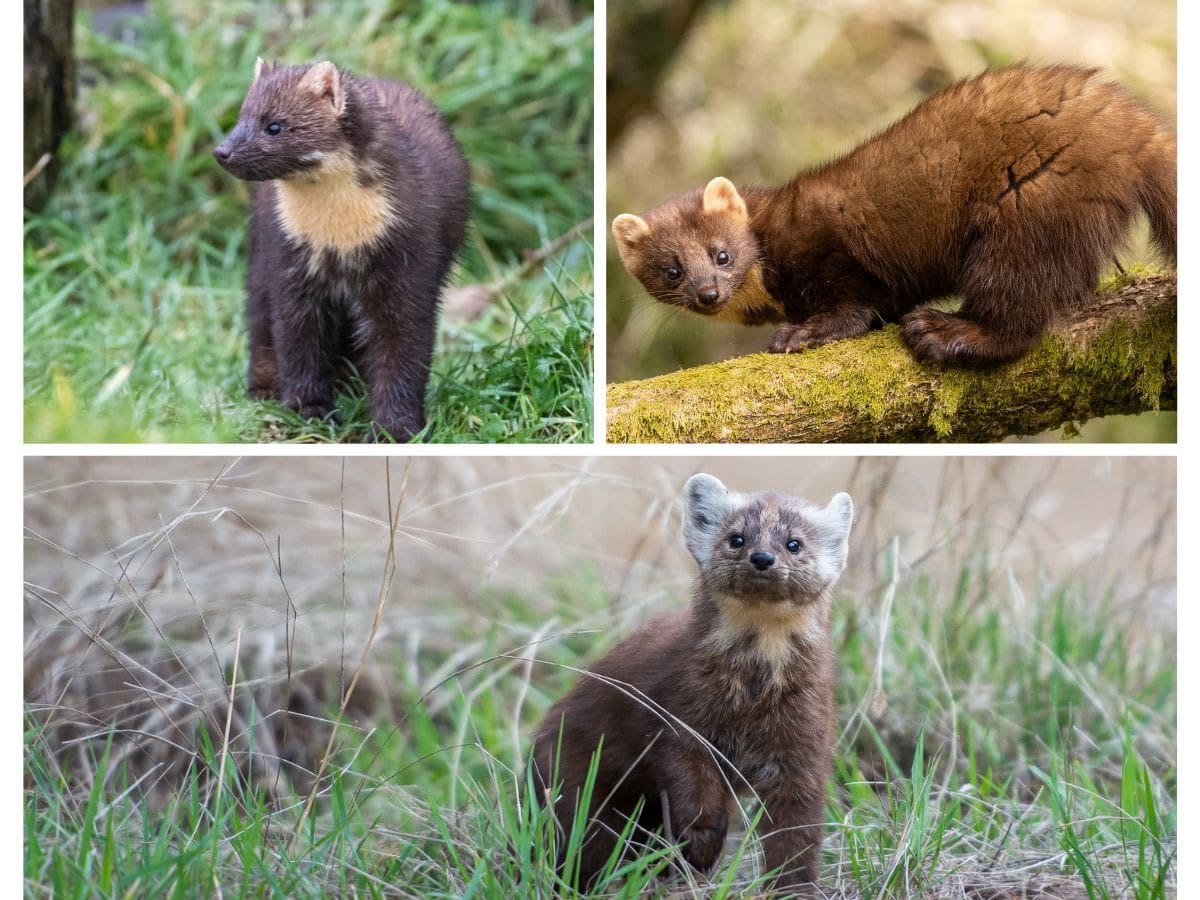
Tips for Spotting Pine Martens in Scotland
Here are 10 tips for anyone who wants to see pine martens in Scotland:
1: Research places where pine martens are known to live – The Scottish Wildlife Trust and Forestry and Land Scotland have identified many of their preferred areas.
2: Visit during the right time of day – Pine martens are nocturnal animals so the best time to see them is during the early morning or late evening.
3: Use binoculars – Pine martens are difficult to see amongst tree branches so a good pair of binoculars will help you get a closer look. If you don’t have a pair yet, check out my binocular reviews.
4: Dress appropriately – Dress warmly and wear clothing that blends in with the natural environment. Pine martens are very wary of humans so it’s important to avoid wearing bright or colourful clothing that could scare them away.
5: Be quiet – Pine martens have excellent hearing so it’s important to move quietly and avoid making sudden movements or loud noises.
6: Find a good vantage point – Look for a spot where you can watch them from a distance, such as a bird hide or a natural shelter.
7: Use scentless midge repellent – Scented bug sprays can be a turn-off for pine martens, so opt for scentless options instead. You’ll find a list of the best midge repellents to use in Scotland in this article.
8: Don’t feed them – While it may be tempting to leave food out to attract pine martens, it’s important to avoid doing so. Feeding wild animals can disrupt their natural behaviour and make them more reliant on humans.
9: Be patient – Seeing a pine marten in the wild requires patience and more than a wee bit of luck. Don’t give up if you don’t see one right away.
10: Consider booking a guided tour – Joining tours with experienced guides can increase your chances of seeing pine martens, and in addition, the guides will provide valuable insights into their behaviour and habitats. This tour of the Wild Highlands is highly recommended for seeing Scottish wildlife.
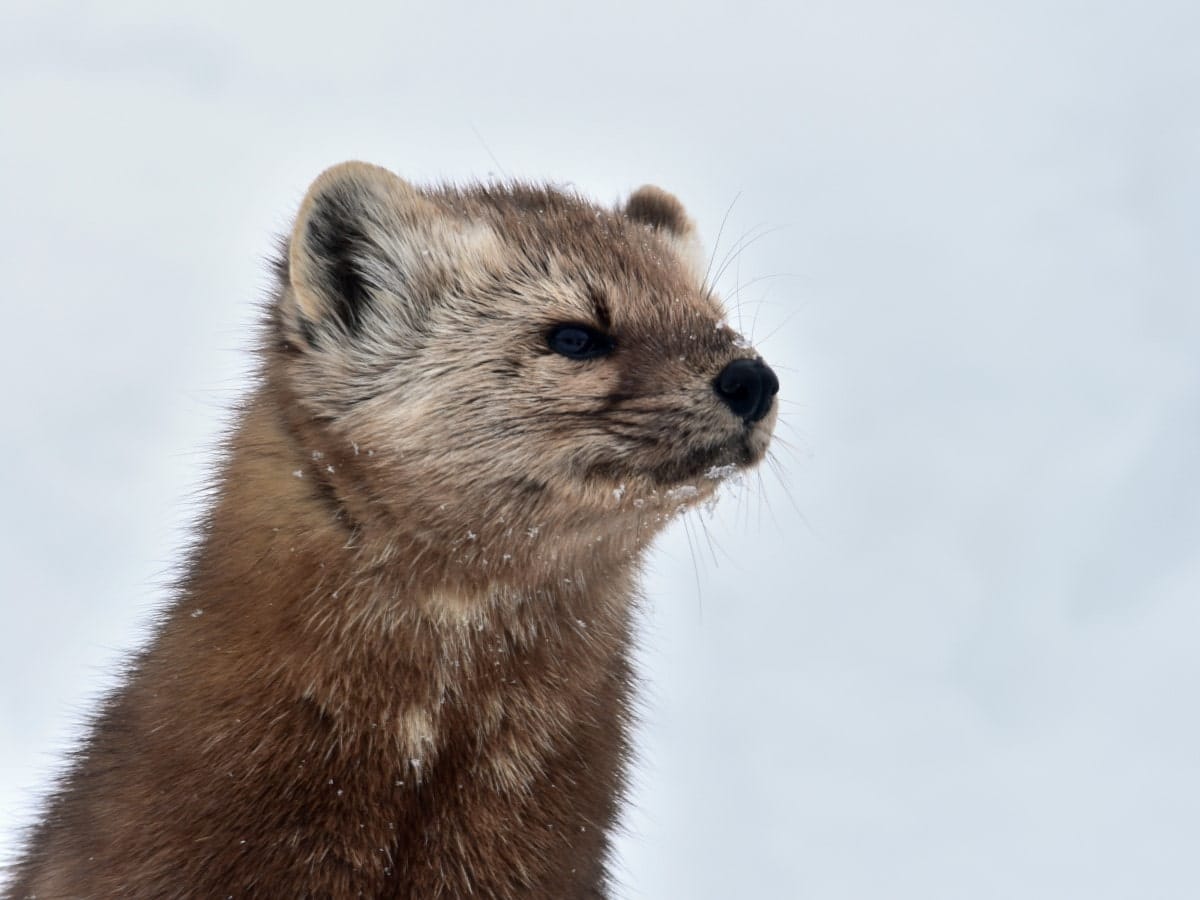
What Time of Day Is Best to See Pine Martens?
If you’re planning to visit Scotland and have your heart set on seeing pine martens, timing is everything. They are primarily nocturnal, which means your best chance of spotting them is during the early hours of the morning or late in the evening.
These are the times when the sun is either just below the horizon or just above it. Pine martens are known to forage for food during these periods, and if you’re lucky enough to spot one, you’ll be treated to a rare and very special sight indeed.
The best time of year to see pine martens in Scotland is from March to May and September to November. During the winter months, pine martens are less active, which in turn makes them less visible, while during the summer months, the trees are in full leaf, which makes it harder to spot them. However, from March to May and September to November, the trees are either just budding or losing their leaves, which makes it easier to see animals moving through the forest.
Also, during the autumn months, pine martens are busy collecting food for the winter, so they’re more active during the day. During the spring months, meanwhile, pine martens are busy giving birth, so you may be lucky enough to see a mother foraging for food with her young from March to May.
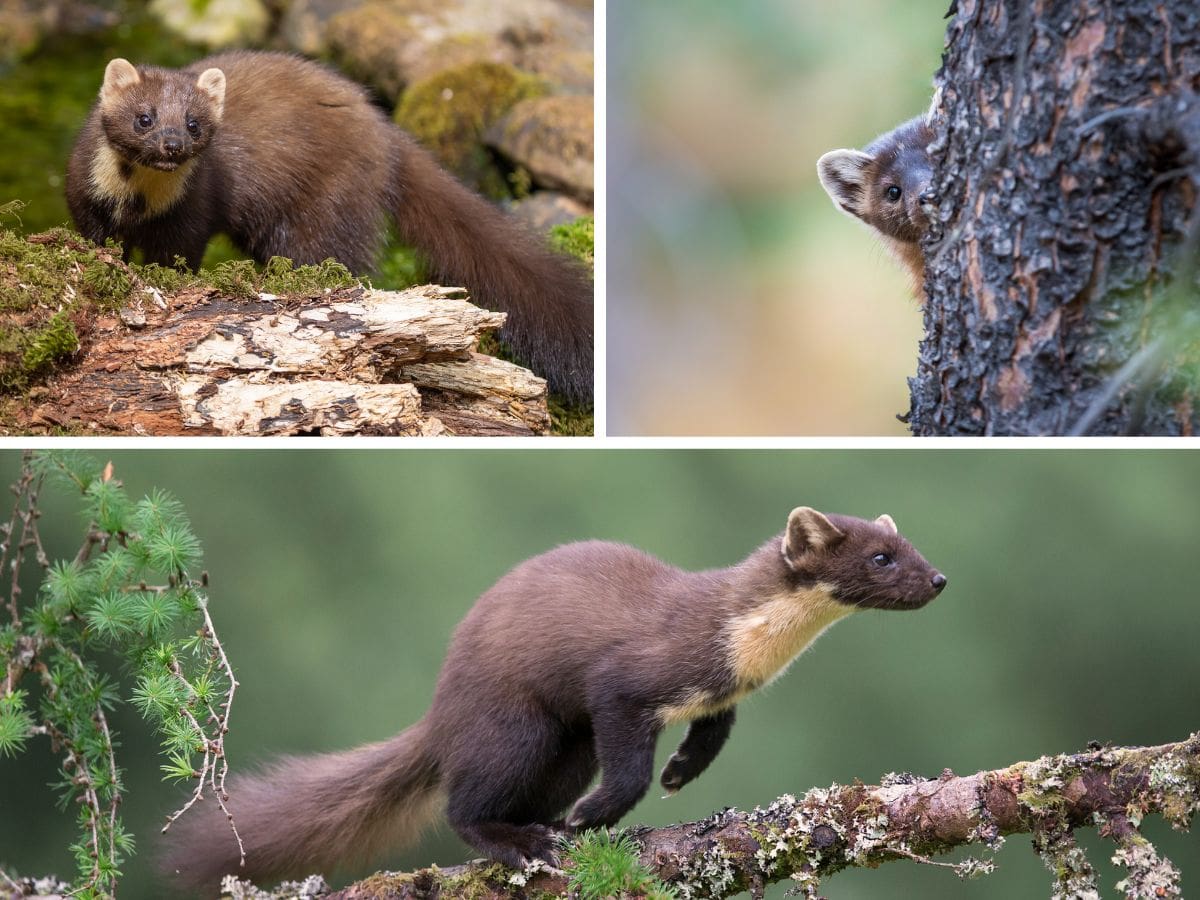
What Does a Pine Marten Eat?
Though classified as carnivores, pine martens are actually opportunistic omnivores, which means they will eat a variety of different foods depending on what is available. Their diet consists of small rodents such as voles, mice, and shrews, which make up around 40% of their food source, but they are also known to prey on birds and insects. Pine martens have even been seen catching and eating relatively large prey like rabbits, though this is less common.
In addition to eating meat, pine martens supplement their diet with fruit, nuts, and seeds, especially during the autumn months when these foods are more abundant. Their favourite berries are from trees such as rowan, hawthorn, and juniper, and they particularly enjoy munching nuts from hazel and beech trees.
One interesting fact about pine martens is that they’re one of the few animals in Scotland that eat squirrels, and in particular, grey squirrels which are classed as an invasive species – more on that later.
What Is the Pine Marten Population in Scotland?
There are an estimated 3,700 adult pine martens in Scotland.
For many years, the population of pine martens in Scotland was in decline due to habitat loss and hunting. While it’s true that pine martens are still considered a threatened species, their population in Scotland is currently stable and even increasing. In fact, pine martens have been expanding their range and can now be found in many areas where they were previously absent, such as the Scottish Borders.
Are Pine Martens Protected in Scotland?
This significant increase in their population is thanks to conservation efforts and protective legislation like the Wildlife and Countryside Act 1981 which has made it an offence to intentionally or recklessly kill, injure, or capture a pine marten or disturb a pine marten in a den.
Pine martens are a vital part of Scotland’s ecosystem as they help to control the population of small rodents and insects and they are a valuable indicator of the health of forests and woodlands. The reason for pine marten numbers being so resilient in Scotland is partly due to conservation programmeses thathave helped to protect their habitats and reduce hunting, and partly because of reintroduction programmes into areas where they had previously disappeared.
The pine marten is now found in many parts of Scotland including the Highlands, the Borders, and the central belt, as well as parts of Dumfries and Galloway. While they are still relatively rare, sightings of pine martens are now becoming more commonplace.
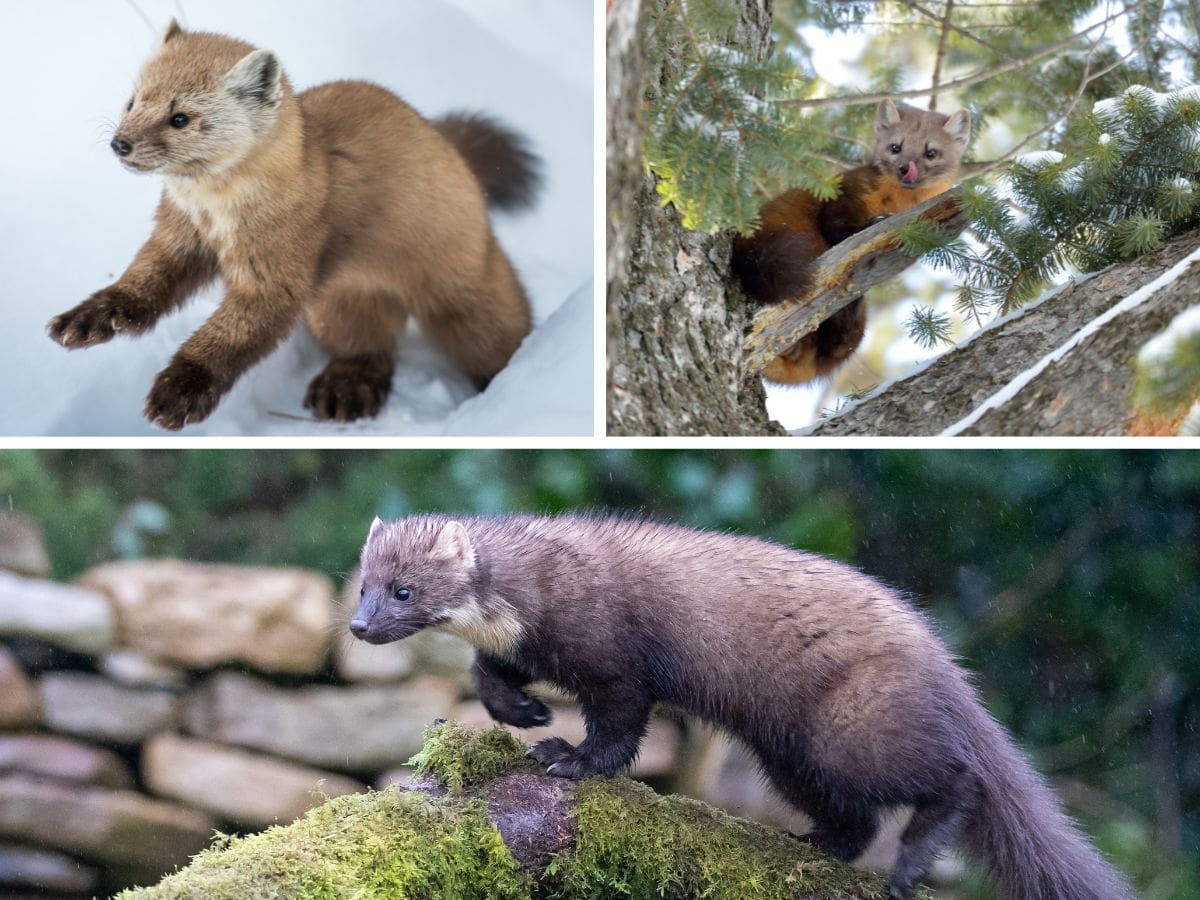
What Is the Biggest Threat to Pine Martens?
Although their numbers have improved in recent years, pine martens still face several threats that jeopardise their survival, the biggest of which is habitat loss. The destruction of forested areas due to commercial forestry and urbanisation is one of the main threats to pine martens as well as most other native Scottish animals.
As pine martens rely on forested areas for food, shelter, and protection, the loss of habitat has had a significant impact on their ability to survive. The fragmentation of wooded areas, which can amplify the effects of habitat loss, also hinders pine martens’ ability to migrate and establish new territories.
Another significant threat to pine martens in Scotland is the competition for resources from the non-native grey squirrel. Grey squirrel numbers have rapidly increased in recent years, which is a real problem because they outcompetepine martens for food.
As far as predators are concerned, both red foxes and golden eagles will actively hunt pine martens which they will kill either as a source of food or to stop them from competing for prey.
While foxes are a threat, a much bigger cause of pine marten deaths is the man-made traps left for foxes, which inadvertently kill other animals as well. Studies have shown that there is a significant impact on the local pine marten population whenever these traps are used.
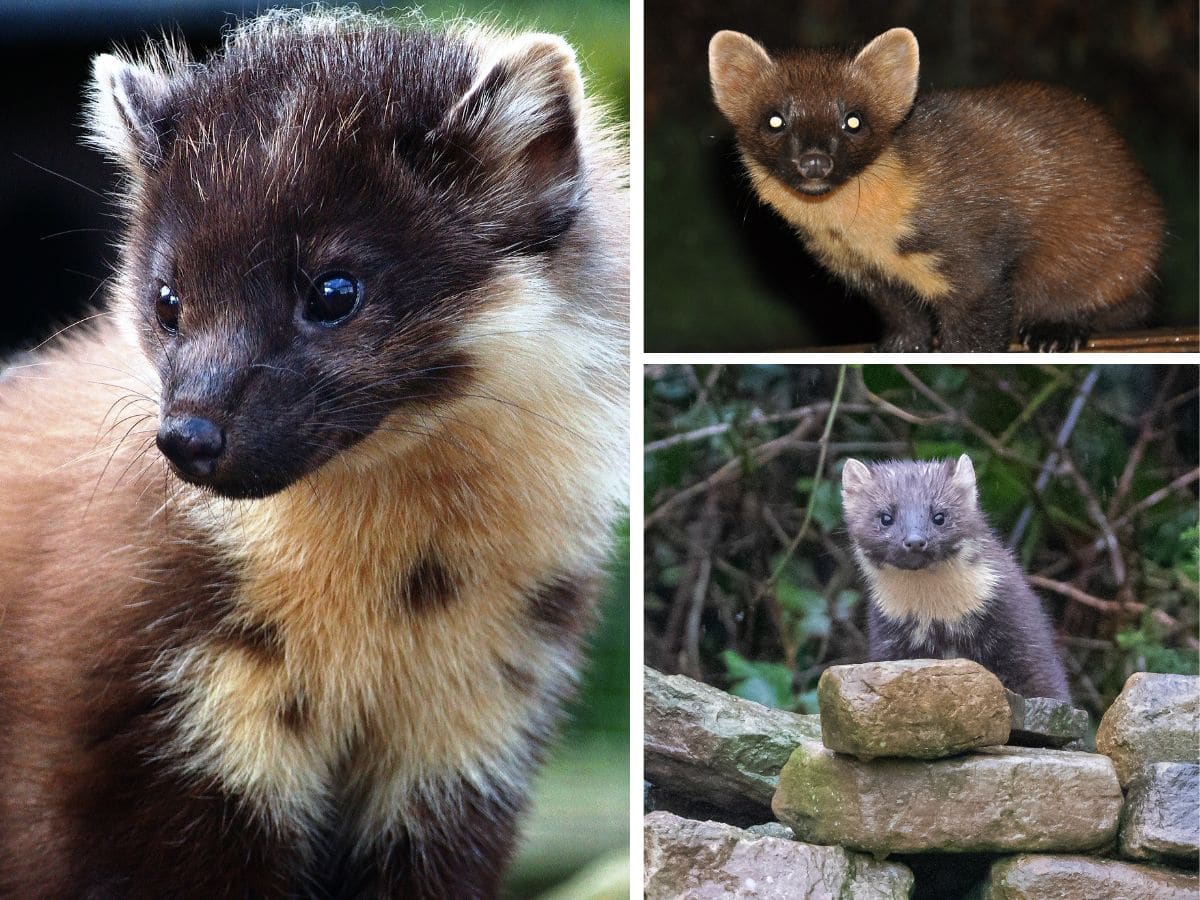
Are Pine Martens Good for Red Squirrels?
One question that often arises is whether pine martens are good for red squirrels. The answer to this question is a resounding yes. Pine martens are natural predators of grey squirrels, which were introduced to Scotland in the 19th century as ornamental animals (the Victorians preferred them to reds because greys spend more time on the ground), but they have since outcompeted and displaced the majority of Britain’s native red squirrels.
Grey squirrels are larger and more aggressive than their red cousins and they also carry a virus called squirrel pox which is fatal to red squirrels. However, pine martens have a particular taste for grey squirrels which means they can help to control their population and give red squirrels a fighting chance for survival.
In fact, studies have shown that in areas where pine martens are present there is a higher proportion of red squirrels compared to areas where they’re absent. In short, pine martens are a vital component of Scotland’s ecosystem and they also play an important role in ensuring the survival of red squirrels.
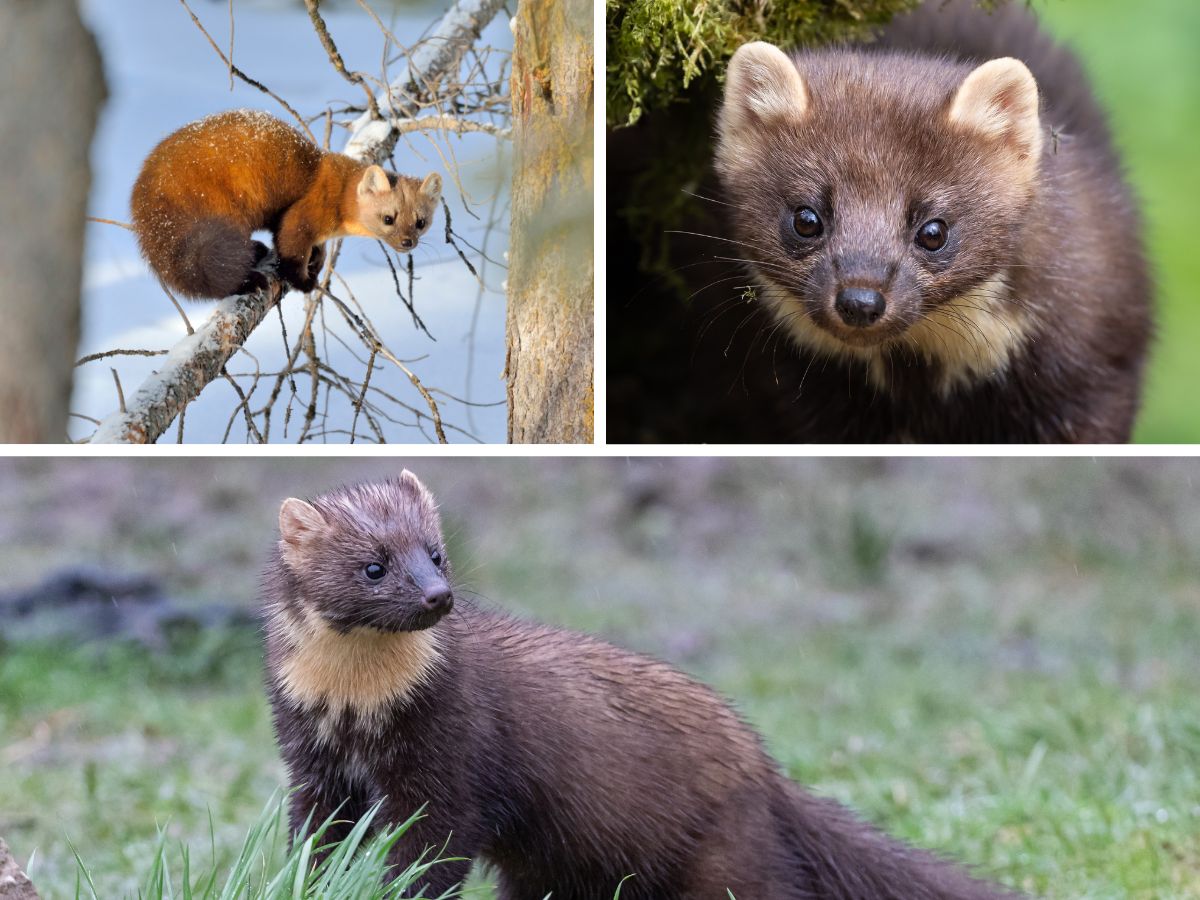
Pine Marten Kits
Pine martens are one of the most iconic mammals found in Scotland and are well known for their bushy tails and characteristic creamy-yellow throat patch. But perhaps the cutest and most endearing aspect of them is their kits.
Pine marten kits are born in litters of two to four, usually in late March or early April. At birth, they are blind, deaf, and completely dependent on their mother for survival.
They spend the first few weeks of their lives tucked away in a den or nest, nursing and sleeping, but as they grow their eyes and ears open and they become more active and playful. By six weeks of age, pine marten kits start being weaned off milk onto solid food, after which they practice climbing trees and honing their hunting skills until they eventually leave their mother to establish their own territories.
If you’re lucky enough to spot a pine marten family in the wild, watch them from a distance and resist the urge to approach or interact with them as doing so will only distress the mother. With patience and a bit of luck, you may just catch a glimpse of these adorable wee critters in their natural habitat.
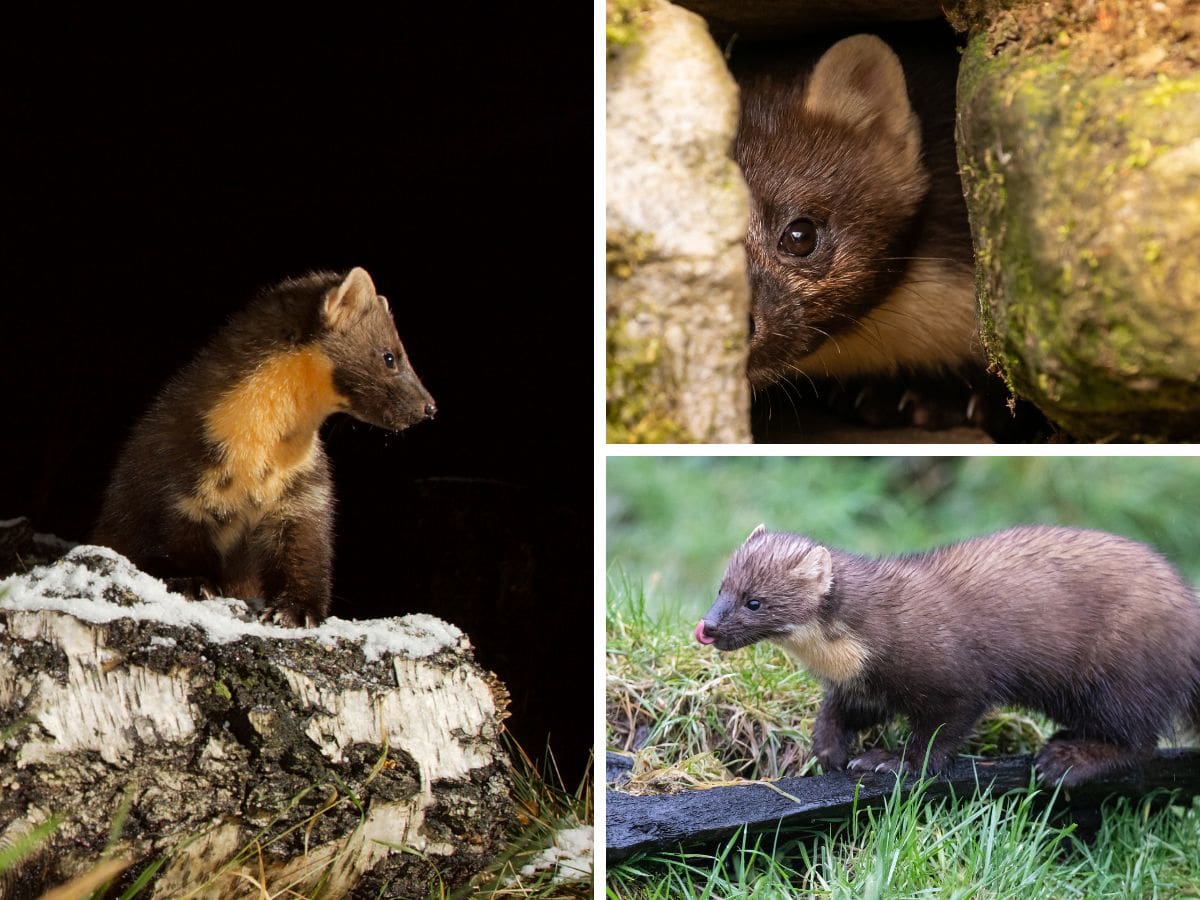
Facts About Pine Martens in Scotland
1: The pine marten’s scientific name is Martes martes, but they are often referred to in Scotland as the ‘cat of the trees’.
2: Pine martens are excellent jumpers, and have been seen to jump up to four meters horizontally!
3: Their fur is thick and silky and ranges in colour from dark brown to reddish brown in Scotland. In other countries, their fur can be a yellowish colour.
4: Pine martens are solitary animals and only come together during the breeding season which usually occurs between July and August.
5: Females give birth to litters of up to five kits.
6: Pine martens are an essential part of Scotland’s forests and woodlands as they help to control populations of rodents and insects.
7: While pine martens are classified as critically endangered in most of Britain, in Scotland they can be found in many of the country’s woodland areas from the Scottish Borders to the far north at Caithness.
Frequently Asked Questions
What do pine martens eat in Scotland?
Pine martens are opportunistic feeders, which means they eat a variety of foods depending on what’s available. Their diet typically consists of small mammals such as voles, mice, and squirrels, as well as birds, insects, and fruits.
In Scotland, pine martens have also been known to prey on grey squirrels, which are considered an invasive species.
Where do you find pine martens?
Pine martens are native to Europe and can be found in many countries including Scotland, Ireland, England, and Wales.
In Scotland, pine martens are primarily found in the northern and central regions where there are large areas of forest and woodland. They are more commonly found in coniferous forests but they also inhabit mixed and deciduous woodlands.
Do pine martens only live in Scotland?
Pine martens are not exclusive to Scotland. While Scotland is certainly a stronghold, they can be found throughout Europe and parts of Asia.
In fact, they are one of the most widely distributed carnivores in Europe, with populations found in countries including France, Italy, and as far east as Russia.
Are Scottish pine martens endangered?
Scottish pine martens are currently considered to be rare in Scotland. They have faced significant population declines in the past due to habitat loss and persecution by humans.
In the early 20th century, pine martens were heavily hunted in Scotland for their fur. However, since the introduction of legal protection in the 1980s, their numbers have slowly increased.


